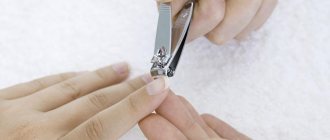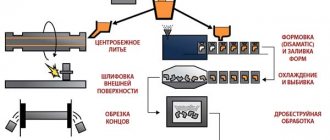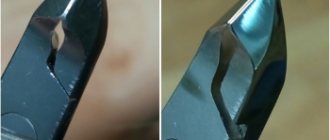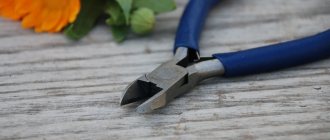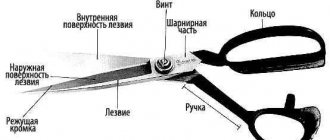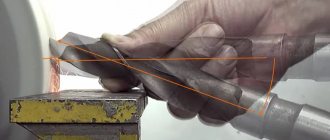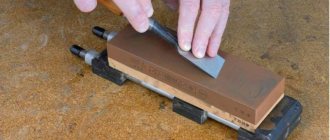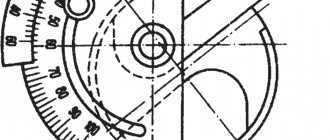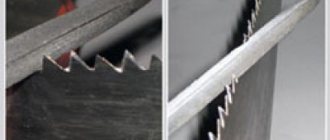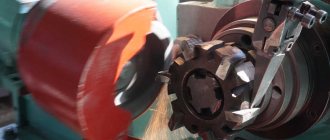Choosing and purchasing a manicure tool is only half the battle, since it requires constant and high-quality maintenance and sharpening. New scissors or forceps can become dull after just a few uses, and some need to be brought into good working condition immediately after purchase. It all depends on the quality of the metal and the initial characteristics of the tool. What does a manicurist need to know about sharpening manicure tools? Is it possible and how to sharpen nail scissors, tongs and cutters at home? How to evaluate and accept a job in the service? Let's look at all the questions in order.
Types of sharpening
There are two directions:
- Conveyor or factory processing
- Manual sharpening
The factory one is of lower quality and often the sharpness is lost after the first 10-15 uses. Even if the blades are initially very sharp, they dull much faster compared to manual processing. Also, the blades may have different sharpness along the length, which is why forceps or scissors tear the cuticle and leave burrs.
Sharpening by hand requires experience, knowledge and skill. It is better to contact a professional in the workshop to get the desired result. Many craftsmen try to sharpen scissors and pliers at home using improvised tools. Yes, perhaps the sharpness will be enough for a couple more procedures, but after that it is still lost, and the service technician has to do more work to eliminate the consequences of home sharpening.
What professional equipment is used for sharpening manicure tools?
Where can you sharpen nail scissors, tweezers, and cutters if you have given up on home experiments and decided to entrust the tools to a professional? There are special workshops that carry out maintenance of manicure equipment.
On average, the cost of such a procedure starts from 300 rubles, and varies depending on the city and country of residence. Many craftsmen in big cities complain that the cost of the service is almost comparable to the purchase of new tools, but this is only if you compare inventory of low and medium price categories. If you are working with high quality products, it is better not to take risks and contact a workshop.
There are two types of professional sharpening machines:
- Mechanical
- Laser
The first ones are equipped with a diamond-coated metal grinding wheel, which, when rotated, grinds down the edges of the tools, giving them the desired sharpness. The method keeps the tool durable and does not shorten the service life.
A laser machine is easier to use, but it wears down the metal faster, making it more fragile. Where to sharpen manicure tools after this? Of course, where the craftsman does it with a high level of quality, regardless of what machine is used.
Useful tips
Recommendations:
- Inexpensive tools do not need to be taken apart. Poor quality fasteners may not withstand being disconnected and reconnected.
- When working with a sharpening machine, it is necessary to set low speed. High rotation speed will damage the cutting edge.
- After purchasing a tool, you need to remember its angle. It must be adhered to during sharpening.
- If you need to sharpen professional manicure tools, it is advisable to use the services of professionals. Carrying out the procedure yourself requires practical experience. To do this, you can practice on old instruments.
- Wear safety glasses when operating the sharpening machine.
- Bars less than 8000 grit are used to smooth out serious damage and chips. If there are no such problems, you should not choose stones less than 8000 grit.
- Do not forget about regular lubrication of moving elements with oil (machine oil, vegetable oil).
- Store tools in a dry case without access to moisture. Constant moisture will cause rust to form.
- After work, clean tweezers, scissors, files, tweezers from dirt and debris.
- A simple option to restore the sharpness of nail scissors is to cut the foil. The sharper the blades are needed, the more cuts required.
It is strictly forbidden to change the angle of the cutting edges, which was made by the manufacturer.
Sharpening manicure instruments is a responsible procedure that will help restore sharpness and perform work more efficiently. However, in order not to permanently spoil the cutting edges, it is necessary to take into account a number of nuances and recommendations of professionals. If it is not possible to spend enough time for sharpening, you need to contact a specialized workshop.
Basic rules for sharpening tools
There are several key points that make up the algorithm for servicing manicure equipment. If all points are completed, we get the desired result.
- When closing scissors, forceps or cutters, nothing should prevent the handles from coming together. If such a problem arises during work, they must be taken to the workshop and all interfering or protruding parts must be ground off on the machine. At home, you can do this with a sharpening stone or rasp, being careful.
- Nippers, cutters and scissors should not dangle, there should be no gap between the cutting planes and at the point of connection of the handles.
- The cutting planes of the nippers should be smooth and close without gaps under gentle pressure.
- The convergence of the cutting edges in the nippers should be uniform from one edge to the other, and not wavy: first the tip, and then the heel, or vice versa.
- The blades should not have protrusions or burrs that catch, scratch or cut the skin.
- The outer edge of the pusher should be sharper than the inner one, and the inner one should have a straight line without jagged edges. The main task of the tool is to move the skin, not cut it.
When sharpening, all factors must be met to obtain the desired result.
Sharpening of pliers, skin tongs, tweezers. If the cutters are loose, they are stuffed at the junction of the blades. They should walk softly and close in an even line. The inside of the nippers is ground down to a straight line from the inside. When closing, the blades should be in the same plane, neither higher nor lower than one another. If there are burrs on the tips of the cutters, they need to be sanded down.
Nippers for manicure and pedicure - types, brands, selection criteria and operating rules
Sharpening pushers.
After processing, they should be sharp, but not cut the skin. They should also not scratch the nail. If the pusher falls and bends, the edge is leveled and then ground down. The pusher is always sharpened on the outside, and only polished on the inside. It is necessary to ensure that the outer edges are not sharp; they should also be ground and sanded.
Types of pushers - comparison, characteristics, operating rules
Sharpening nail scissors.
If the blades were deformed after a fall, the edge will have to be ground down. If the damage is significant, then most often the scissors cannot be repaired. If the deformation is small, then grinding helps eliminate it, but the length of the blades will be reduced.
When sharpening scissors, only the front surface is removed. You cannot go into the rear one; it was processed only once at the factory, and this is enough for the entire operating cycle. After each grinding of a layer, it is necessary to remove the metal grain from the blades so as not to damage them when closing.
Nail scissors - types, proper use, choosing the best
The sharpening angle of the scissors must correspond to the factory rake angle and cannot be changed. Usually it is 60-75°.
At the final stage, it is recommended to go over the blades with fine-grained sandpaper to remove burrs.
Sharpening manicure knives.
They are used mainly for pedicures, to remove rough skin and corns. The manicure knife should not be very sharp; the factory angle should be maintained and the edge should not be ground into a bayonet.
How and with what to check the sharpening level
Even a professional manicure cannot be done with a blunt instrument. That is why regular maintenance of tongs, scissors, and tweezers is necessary. With a large flow of clients in the salon, maintenance of scissors and cutters may be required once every two to three weeks. With a lower flow - much less often.
To understand when it's time to sharpen your manicure tools, there are a number of simple tests. They will require the following materials to choose from:
- Thin plastic bag
- Stretch film
- Dried wet wipe made of non-woven material
- Elastic vinyl, latex or nitrile gloves
These same tests will allow you to check the quality of the work performed by the master. In the workshop, these tests are used to check each of the processing stages of blades and cutting edges.
Methods and instructions on how to check the quality and level of sharpening:
- We fix the thin plastic bag so that the edge is even. Unclench the scissors, tongs or wire cutters, place the edge of the bag between them, and close along the entire length. The blades should not tear, snag or pull the polyethylene.
- Stretch film is the most demanding material for checking the level of sharpening. The principle is the same - we fix the film and close the blades along its entire length. The cut should be smooth.
- A napkin made of non-woven material demonstrates well the presence of burrs on metal. With high-quality processing, the cut is smooth, without snagging on the blade.
- Vinyl or nitrile gloves should be secured between the thumb and forefinger, the cutting edges should be completely opened and closed, placing the glove sheet between the blades, and then pulled down slightly towards you. Often scissors or tongs cut well at the base, but the closed edge pulls the glove and tears it. This means it's time to sharpen the blades again.
Signs of a dull instrument
Typically, a blunt tool has jagged edges; sometimes of scissors and wire cutters differ The tips and cutting edges become so thick that it is almost impossible to grip the skin or remove an ingrown toenail.
The frequency of sharpening depends on how often you use the manicure set. Usually the need for it occurs once every 2-6 months .
This video will tell you how to sharpen nail clippers:
Proper sharpening of manicure tools at home
How to sharpen manicure tweezers, scissors and nippers at home? This can be done at home using a grinding wheel or by hand. If you don't have experience with this, it's better to ask someone who has tried it or knows how to do it. Otherwise, you need to take the manicure tools to the workshop.
If you still decide to carry out the procedure at home, you will need:
- Sharpening stone or rasp
- Sandpaper, hard and sanding
- Any of the above materials to check the level of sharpening
A block or rasp is suitable for processing large areas. They should work smoothly, respecting the factory angles. Next, the blades are sanded with sandpaper. It can be secured with tape to the handle of a spoon or a wide nail file for additional support.
You can get by with just sandpaper, first 600 grit and then 1500 grit, to smooth out any burrs on the metal.
Some craftsmen use foil folded in 4-8 layers, finely cutting it with a tool to the desired degree of sharpening. Reviews about this method are mixed, so if you have an expensive, high-quality instrument, it’s better not to risk it.
Everyone should mind their own business, and if possible, it is better to have the tools serviced by a professional. If you decide to do the treatment at home, follow all recommendations.
Professional work
In big cities, finding a workshop for sharpening manicure tools is not a problem. Professional craftsmen necessarily use in their work several machines for sharpening nail clippers, lamps with different lighting, lubricating compounds and many other devices.
Large workshops even accept wholesale orders for tool sharpening from salons, and the quality of their work should not change.
It is difficult to find good professionals in small towns. As a rule, there can be one master for the entire settlement, and sometimes you have to go to a neighboring city to get his services. The lack of competition often makes it possible to perform poorly. In such situations, you can find the best master nearby and ask him for training, or use your own experience and the advice below to try to sharpen the tools yourself.
